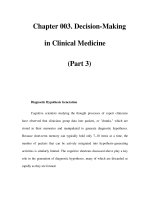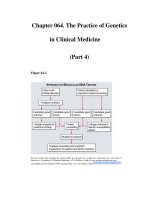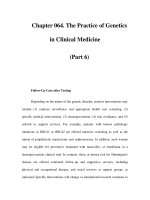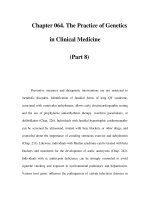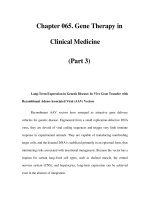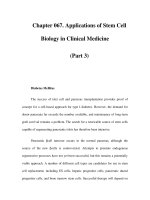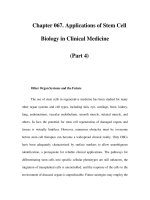Urological Emergencies in Clinical Practice - part 3 pot
Bạn đang xem bản rút gọn của tài liệu. Xem và tải ngay bản đầy đủ của tài liệu tại đây (469.29 KB, 20 trang )
diagnosis of PUJO becomes likely, and a renogram (e.g., MAG3
scan) should be done to confirm the diagnosis (Fig. 3.9).
ACUTE PYELONEPHRITIS
Clinical Definition
This is a clinical diagnosis, made on the basis of fever, flank pain,
and tenderness, often with an elevated white count. It may affect
32 J. REYNARD
FIGURE 3.8. JJ stent post insertion.
3. NONTRAUMATIC RENAL EMERGENCIES 33
FIGURE 3.9. a: Right pelviureteric junction (PUJ) obstruction on ultra-
sound. b: PUJ obstruction on CT. Note the normal-calibre ureter with
hydronephrosis above. c: MAG3 renogram of PUJ obstruction demon-
strating obstruction to excretion of radioisotope by the kidney. (See this
figure in full color in the insert.)
one or both kidneys. There are usually accompanying symptoms
suggestive of a lower urinary tract infection (frequency, urgency,
suprapubic pain, urethral burning or pain on voiding) that led
to the ascending infection, which resulted in the subsequent
acute pyelonephritis. The infecting organisms are commonly
Escherichia coli, enterococci (Streptococcus faecalis), Klebsiella,
Proteus, and Pseudomonas.
a
b
Urine culture is positive for bacterial growth, but the bacte-
rial count may not always be above the 100,000 colony-forming
units (cfu)/mL of urine, which is the strict definition for urinary
infection. Thus, if you suspect a diagnosis of acute pyelonephri-
tis from the symptoms of fever and flank pain, but there are only
1000 cfu/mL, manage the case as acute pyelonephritis.
Investigation and Treatment
For those patients who have a fever but are not systemically
unwell, outpatient management is reasonable. Culture the urine
and start oral antibiotics according to your local antibiotic policy
(which will be based on the likely infecting organisms and their
likely antibiotic sensitivity). We use oral ciprofloxacin, 500mg
b.i.d. for 10 days.
If the patient is systemically unwell, admit them to hospital
culture urine and blood, and start intravenous fluids and intra-
venous antibiotics, again selecting the antibiotic according to
your local antibiotic policy. We use i.v. ampicillin 1g t.i.d. and
gentamicin, 3 mg/kg as a once daily dose.
Arrange for a kidney and urinary bladder (KUB) x-ray and
renal ultrasound, to see if there is an underlying upper tract
abnormality (such a ureteric stone), unexplained hydronephro-
sis, or (rarely) gas surrounding the kidney (suggesting emphyse-
matous pyelonephritis).
34 J. REYNARD
F
IGURE 3.9. Continued
c
If the patient does not respond within 3 days to this regimen
of appropriate intravenous antibiotics (confirmed on sensitivi-
ties), arrange for a CTU (Fig. 3.10). The lack of response to treat-
ment indicates that you are dealing with a pyonephrosis (i.e.,
pus in the kidney, which like any abscess will respond only to
drainage), a perinephric abscess (which again will respond only
to drainage), or emphysematous pyelonephritis. The CTU may
demonstrate an obstructing ureteric calculus that may have been
missed on the KUB x-ray, and ultrasound and will show a per-
inephric abscess if present. A pyonephrosis should be drained by
insertion of a percutaneous nephrostomy tube. A perinephric
abscess should also be drained by insertion of a drain
percutaneously.
If the patient responds to i.v. antibiotics, change to an oral
antibiotic of appropriate sensitivity when they become apyrexial,
and continue this for approximately 10 to 14 days.
3. NONTRAUMATIC RENAL EMERGENCIES 35
F
IGURE 3.10. A CTU without contrast in a diabetic patient with left acute
pyelonephritis. Note the incidental finding of a nonobstructing left renal
calculus.
PYONEPHROSIS
This is an infected hydronephrosis, the infection being severe
enough to cause accumulation of pus with the renal pelvis
and calyces of the kidney. The causes are essentially those
of hydronephrosis, where infection has supervened. Thus, they
include ureteric obstruction by stone and PUJ obstruction.
Patients with pyonephrosis are usually very unwell, with a
high fever, flank pain, and tenderness. Again, a patient with this
combination of symptoms and signs will usually be investigated
by a renal ultrasound, where the diagnosis of a pyonephrosis is
usually obvious (Fig. 3.11).
Treatment consists of i.v. antibiotics (as for pyelonephritis),
i.v. fluids, and percutaneous nephrostomy insertion.
36 J. REYNARD
FIGURE 3.11. a: The appearance of a pyonephrosis on ultrasound. Note
the hyperreflective material within the dilated system. b: A right
pyonephrosis on CT, done without contrast. Note the presence of a stone
in the kidney. c: A right pyonephrosis on CT postcontrast administration.
a
3. NONTRAUMATIC RENAL EMERGENCIES 37
FIGURE 3.11. Continued
b
c
PERINEPHRIC ABSCESS
Perinephric abscess (Fig. 3.12) develops as a consequence of
extension of infection outside the parenchyma of the kidney in
acute pyelonephritis, or more rarely, nowadays, from haematoge-
nous spread of infection from a distant site. The abscess devel-
ops within Gerota’s fascia—the fascial layer surrounding the
kidneys and their cushion of perinephric fat. These patients are
often diabetic, and associated conditions such as an obstructing
ureteric calculus may be the precipitating event leading to
development of the perinephric abscess. Failure of a seemingly
straightforward case of acute pyelonephritis to respond to
intravenous antibiotics within a few days should arouse your
suspicion that there is something else going on, such as the
accumulation of pus in or around the kidney, or obstruction with
infection. Imaging studies, such as ultrasound and more espe-
cially CT, will establish the diagnosis and allow radiographically
controlled percutaneous drainage of the abscess. However, if the
pus collection is large, formal open surgical drainage under
general anaesthetic will be provide more effective drainage.
EMPHYSEMATOUS PYELONEPHRITIS
This is a rare and severe form of acute pyelonephritis caused by
gas-forming organisms (Fig. 3.13). It is characterised by fever
38 J. REYNARD
FIGURE 3.12. A left perinephric abscess as seen on CT.
3. NONTRAUMATIC RENAL EMERGENCIES 39
FIGURE 3.13. a: A case of emphysematous pyelonephritis on plain
abdominal x-ray. Note the presence of gas within the left kidney. b: A CT
of the same case. The gas in the kidney (like that in the bowel) is black
on CT. c: A percutaneous drain has been inserted with the patient lying
prone. Note the J loop of the drain in the kidney.
a
40 J. REYNARD
FIGURE 3.13. Continued
b
c
and abdominal pain, with radiographic evidence of gas within
and around the kidney (on plain radiography or CT). It usually
occurs in diabetics, and in many cases is precipitated by urinary
obstruction by, for example, ureteric stones. The high glucose
levels of the poorly controlled diabetic provides an ideal
environment for fermentation by enterobacteria, carbon dioxide
being produced during this process.
Presentation
Emphysematous pyelonephritis presents as a severe acute
pyelonephritis (high fever and systemic upset) that fails to
respond within 2 to 3 days with conventional treatment in the
form of intravenous antibiotics. E. coli is a common causative
organism, with Klebsiella and Proteus occurring from time to
time. Obtaining a KUB x-ray and ultrasound in all patients with
acute pyelonephritis may allow earlier diagnosis of this rare form
of pyelonephritis. An unusual distribution of gas on x-ray may
suggest that the gas lies around the kidney (e.g., crescent or
kidney shaped). Renal ultrasonography often demonstrates
strong focal echoes, indicating gas within the kidney. Intrarenal
gas will be clearly seen on CT scan.
Treatment
Patients with emphysematous pyelonephritis are usually very
unwell. Mortality is high. Selected patients can be managed con-
servatively, by intravenous antibiotics and fluids, percutaneous
drainage, and careful control of diabetes. In those where sepsis
is poorly controlled, emergency nephrectomy is required.
ACUTE PYELONEPHRITIS, PYONEPHROSIS, PERINEPHRIC
ABSCESS, AND EMPHYSEMATOUS PYELONEPHRITIS—
MAKING THE DIAGNOSIS
Maintaining a degree of suspicion in all cases of presumed acute
pyelonephritis is the single most important thing in making
an early diagnosis of complicated renal infection, such as
a pyonephrosis, perinephric abscess, or emphysematous
pyelonephritis. If patients are very unwell, or diabetic, or have a
history suggestive of stones, for example, ask yourself whether
they may have something more than just a simple acute
pyelonephritis. They may give a history of sudden onset of severe
flank pain a few days earlier, which suggests that they may have
passed a stone into their ureter at this stage, and that later
infection supervened.
3. NONTRAUMATIC RENAL EMERGENCIES 41
A policy of arranging for a KUB x-ray and renal ultrasound in
all patients with suspected renal infection is wise. The main clin-
ical indicators that suggest you may be dealing with a more
complex form of renal infection are length of symptoms prior to
treatment and time taken to respond to treatment. Thorley and
colleagues (1974) reviewed a series of 52 patients with per-
inephric abscess. They noted that the majority of patients with
uncomplicated acute pyelonephritis had been symptomatic for
less than 5 days, whereas most of those with a perinephric abscess
had been symptomatic for more than 5 days prior to hospitalisa-
tion. In addition, all patients with acute pyelonephritis became
afebrile after 4 days of treatment with an appropriate antibiotic,
whereas patients with perinephric abscesses remained pyrexial.
XANTHOGRANULOMATOUS PYELONEPHRITIS
This is a severe renal infection usually (though not always) occur-
ring in association with underlying renal calculi and renal
obstruction. The severe infection results in destruction of renal
tissue, and a nonfunctioning, enlarged kidney is the end result.
E. coli and Proteus are common causative organisms.
Macrophages full of fat become deposited around abscesses
within the parenchyma of the kidney. The infection may be con-
fined to the kidney or extend to the perinephric fat. The kidney
becomes grossly enlarged and macroscopically contains yellow-
ish nodules, pus, and areas of haemorrhagic necrosis. It can be
very difficult to distinguish the radiological findings from a renal
cancer on imaging studies such as CT (Fig. 3.14). Indeed, in most
cases the diagnosis is made after nephrectomy for a presumed
renal cell carcinoma.
Presentation and Imaging Studies
Patients present acutely with flank pain and fever, with a tender
flank mass. Bacteria (E. coli, Proteus) may be found on culture
urine. Renal ultrasonography shows an enlarged kidney con-
taining echogenic material. On CT, renal calcification is usually
seen, within the renal mass. Nonenhancing cavities are seen, con-
taining pus and debris. On radioisotope scanning, there may be
some or no function in the affected kidney.
Management
On presentation these patients are usually commenced on anti-
biotics as the constellation of symptoms and signs suggests
infection. When imaging studies are done, such as CT, the
appearances usually suggest the possibility of a renal cell carci-
42 J. REYNARD
noma, and therefore when signs of infection have resolved, the
majority of patients will proceed to nephrectomy. Only following
pathological examination of the removed kidney will it become
apparent that the diagnosis was one of infection (xanthogranu-
lomatous pyelonephritis) rather than one of a tumour.
References
Caro JJ, Trindale E, McGregor M. The risks of death and severe non-fatal
reactions with high vs low osmolality contrast media. AJR 1991;
156:825–832.
Holm-Nielsen A, Jorgensen T, Mogensen P, Fogh J. The prognostic value
of probe renography in ureteric stone obstruction. Br J Urol 1981;
53:504–507.
Khadra MH, Pickard RS, Charlton M, et al. A prospective analysis of
1,930 patients with hematuria to evaluate current diagnostic prac-
tice. J Urol 2000;163:524–527.
Kobayashi T, Nishizawa K, Mitsumori K, Ogura K. Impact of date of
onset on the absence of hematuria in patients with acute renal colic.
J Urol 2003;1770:1093–1096.
Laerum E, Ommundsen OE, Granseth J, et al. Intramuscular diclofenac
versus intravenous indomethacin in the treatment of acute renal
colic. Eur Urol 1996;30:358–362.
3. NONTRAUMATIC RENAL EMERGENCIES 43
FIGURE 3.14. A case of xanthogranulomatous pyelonephritis (left) as seen
on CT. This can be very difficult to distinguish radiologically from a renal
cancer.
Louca G, Liberopoulos K, Fidas A, et al. MR urography in the diagnosis
of urinary tract obstruction. Eur Urol 1999;35:14.
Luchs JS, Katz DS, Lane DS, et al. Utility of hematuria testing in patients
with suspected renal colic: correlation with unenhanced helical CT
results. Urology 2002;59:839.
O’Malley ME, Soto JA, Yucel EK, Hussain S. MR urography: evaluation
of a three-dimensional fast spin-echo technique in patients with
hydronephrosis. AJR 1997;168:387–392.
Segura JW, Preminger GM, Assimos DG, et al. Ureteral Stones Guidelines
Panel summary report on the management of ureteral calculi. J Urol
1997;158:1915–1921.
Smith RC, Verga M, McCarthy S, Rosenfield AT. Diagnosis of acute flank
pain: value of unenhanced helical CT. AJR 1996;166:97–101.
Thomson JM, Glocer J, Abbott C, et al. Computed tomography versus
intravenous urography in diagnosis of acute flank pain from
urolithiasis: a randomized study comparing imaging costs and
radiation dose. Australas Radiol 2001;45:291–297.
Thorley JD, Jones SR, Sanford JP. Perinephric abscess. Medicine 1974;
53:441.
44 J. REYNARD
Chapter 4
Other Infective Urological
Emergencies
Hashim Hashim and John Reynard
URINARY SEPTICAEMIA
Sepsis as a result of a urinary tract infection is a serious condi-
tion that can lead to septic shock and death. Septicaemia or
sepsis is the clinical syndrome caused by bacterial infection of
the blood, confirmed by positive blood cultures for a specific
organism. There should be a documented source of infection
with a systemic response to the infection. The systemic response
is known as the systemic inflammatory response syndrome
(SIRS) and is defined by as at least two of the following:
Fever (>38°C) or hypothermia (<36°C)
Tachycardia (>90 beats/min in patients not on beta-blockers)
Tachypnoea (respiratory rate >20/min or Pa
CO
2
< 4.3 kPa or a
requirement for mechanical ventilation)
White cell count >12,000 cells/mm
3
, <4000 cells/mm
3
, or 10%
immature (band) forms
Severe sepsis or sepsis syndrome is a state of altered organ per-
fusion or evidence of dysfunction of one or more organs, with at
least one of the following: hypoxaemia, lactic acidosis, oliguria,
or altered mental status. Septic shock is severe sepsis with refrac-
tory hypotension, hypoperfusion, and organ dysfunction. This is
a life-threatening condition.
There are many causes of urinary sepsis, but in the hospital
setting the commonest causes from a urological perspec-
tive are the presence of or manipulation of indwelling urinary
catheters, urinary tract surgery, particularly endoscopic [trans-
urethral resection of the prostate (TURP), transurethral re-
section of bladder tumor (TURBT), ureteroscopy, percutaneous
nephrolithotomy (PCNL)] and urinary tract obstruction, partic-
ularly that due to stones obstructing the ureter. In the National
Prostatectomy Audit and the European Collaborative Study of
Antibiotic Prophylaxis for TURP, septicaemia occurred in
approximately 1.5% of men undergoing TURP. Diabetic patients,
patients in the intensive care units (ICU), and patients on
chemotherapy and steroids are more prone to urosepsis.
The commonest causative organisms of urinary sepsis
are Escherichia coli, enterococci (Streptococcus faecalis), sta-
phylococci, Pseudomonas aeruginosa, Klebsiella, and Proteus
mirabilis.
The principles of management include early recognition,
resuscitation, localisation of the source of sepsis, early and
appropriate antibiotic administration, and removal of the
primary source of sepsis. The clinical scenario is usually a post-
operative patient who has undergone TURP or surgery for stone.
Having returned to the ward, the patient becomes pyrexial, starts
to shiver and shake, is tachycardic, and may be confused. On
inspection the patient may initially show signs of peripheral
vasodilatation (may appear flushed and warm to the touch). Look
for symptoms and signs of a non-urological source of sepsis such
as pneumonia. If there are no indications of infection elsewhere,
assume the urinary tract is the source of sepsis.
Investigations
Urine culture. An immediate Gram stain may aid in deciding
which antibiotic to use.
Full blood count. The white blood count is usually elevated.
The platelet count may be low, a possible indication of
impending disseminated intravascular coagulopathy (DIC).
Coagulation screen. This is important if surgical or radiologi-
cal drainage of the source of infection is necessary.
Urea and electrolytes as a baseline determination of renal
function.
Arterial blood gases to identify hypoxia and the presence of
metabolic acidosis.
Blood cultures.
Chest x-ray (CXR), looking for pneumonia, atelectasis, and
effusions.
Depending on the clinical situation, a renal ultrasound may be
helpful to demonstrate hydronephrosis or pyonephrosis and CT
urography (CTU) may be used to establish the presence or
absence of a ureteric stone.
Treatment
Remember A (airway), B (breathing), C (circulation).
Administer 100% oxygen via a face mask.
46 H. HASHIM AND J. REYNARD
Establish intravenous access with a wide-bore intravenous
cannula, e.g., 16 or 18 gauge.
Start an intravenous infusion of crystalloid e.g., normal saline
or colloid e.g., Gelofusin.
Catheterise the patient to monitor urine output.
Start empirical antibiotic therapy (see below). This should be
adjusted later when cultures are available.
If there is septic shock, the patient needs to be transferred to
the ICU. Inotropic support may be needed. Steroids may be
used as adjunctive therapy in gram-negative infections.
Naloxone may help revert endotoxic shock. This should all be
done under the supervision of an intensivist.
Treat the underlying cause. Drain any obstruction and remove
any foreign body. If there is a stone obstructing the ureter,
then either ask the radiologist to insert a nephrostomy tube
to relieve the obstruction or take the patient to the operating
room and insert a JJ stent. Send any urine specimens obtained
for microscopy and culture.
Empirical Treatment
Empirical antibiotic treatment is the ‘blind’ use of antibiotics
based on an educated guess of the most likely pathogen that has
caused the sepsis. In urinary sepsis, the cause is often a gram-
negative rod. Gram-negative aerobic rods include the enterobac-
teria, e.g., E. coli, Klebsiella, Citrobacter, Proteus, and Serratia. The
enterococci (gram-positive aerobic nonhaemolytic streptococci)
may sometimes cause urosepsis. In urinary tract operations
involving bowel, anaerobic bacteria may be the cause of urospe-
sis and in wound infections staphylococci, e.g., staphylococcus
aureus and staphylococcus epidermidis are the usual cause.
The recommendations for treatment of urosepsis include
(Naber 2001):
A third-generation cephalosporin, e.g., cefotaxime IV, ceftri-
axone IV. These are active against gram-negative bacteria, but
less active against staphylococci and gram-positive bacteria.
Ceftazidime also has activity against Pseudomonas aerugi-
nosa. It is therefore important to get an urgent gram stain
on any fluid sample sent to the laboratory. About 5% of
patients who are allergic to penicillin are also allergic to
cephalosporins, so enquire about penicillinallergy and con-
sider alternative antibiotics.
Fluoroquinolones, e.g., ciprofloxacin, can be used instead of
cephalosporins. They exhibit good activity against enterobac-
4. OTHER INFECTIVE UROLOGICAL EMERGENCIES 47
taria and P. aeruginosa, but less activity against staphylococci
and enterococci. Ciprofloxacin can be given both orally and
intravenously. It is well absorbed from the gastrointestinal
tract.
Metronidazole is used if there is suspicion of an anaerobic
source of sepsis.
Other drugs that can be used if there is no clinical response
to the above include a combination of piperacillin and tazo-
bactam. This combination is active against enterobacteria,
enterococci, and Pseudomonas.
Gentamicin is used in conjunction with other antibiotics
because it has a relatively narrow therapeutic spectrum
(against gram-negative organisms). Close monitoring of ther-
apeutic levels and renal function is important. It has good
activity against enterobacteria and Pseudomonas, with poor
activity against streptococci and anaerobes and therefore
should ideally be combined with b-lactam antibiotics, e.g., co-
trimoxazole but can be combined with ciprofloxacin instead.
If there is clinical improvement, intravenous treatment should
continue for at least 48 hours with oral medication thereafter.
Make appropriate adjustments when the sensitivity results are
available from the urine cultures that were sent. It may take
about 48 hours for sensitivity results to become available.
PYELONEPHRITIS AND PYONEPHROSIS
See Chapter 3.
PROSTATIC INFECTIONS AND PROSTATIC ABSCESS
Acute Bacterial Prostatitis [National Institute of Health
Classification System (Krieger 1999) Category I Prostatitis]
Acute bacterial prostatitis is infection of the prostate associated
with lower urinary tract infection and generalised sepsis. E. coli
is the commonest cause. Pseudomonas, Serratia, Klebsiella, and
enterococci are less common causes.
The presenting symptoms include acute onset of perineal and
suprapubic pain with irritative (frequency, urgency, pain on
voiding) and obstructive (hesitancy, poor flow, acute retention)
lower urinary tract symptoms, combined with fever, chills, and
malaise. The infection may be severe enough to cause
septicaemia.
The patient shows signs of systemic toxicity (fever, tachycar-
dia, hypotension), combined with suprapubic tenderness and a
48 H. HASHIM AND J. REYNARD
palpable bladder if in urinary retention. On digital rectal exam-
ination the prostate is extremely tender.
Treatment consists of intravenous antibiotics, pain relief and
relief of retention if present. Traditional teaching recommended
a suprapubic catheter be inserted, rather than a urethral catheter,
to avoid the potential obstruction of prostatic urethral ducts by
a urethral catheter with retention of infected secretions and pus.
However, in-and-out catheterisation or short periods with an
indwelling catheter probably do no harm, and this is certainly an
easier way of relieving retention than suprapubic catheterisation.
Prostatic Abscess
Failure to respond to the treatment regimen outlined above
(persistent symptoms and persistent fever while on antibiotic
therapy) suggests the development of a prostatic abscess. A tran-
srectal ultrasound, or computed tomography (CT) scan if the
former proves too painful, is the best way of diagnosing a pro-
static abscess (Fig. 4.1). This may be drained by a transurethral
incision or deroofing using a resectoscope.
FOURNIER’S GANGRENE
Fournier’s gangrene (Fig. 4.2) is a necrotising fasciitis affecting
the genitalia and perineum. It primarily affects males. Necrosis
4. OTHER INFECTIVE UROLOGICAL EMERGENCIES 49
FIGURE 4.1. A computed tomography scan of a prostatic abscess.
and subsequent gangrene of infected tissues occurs. Culture of
infected tissue reveals a combination of aerobic (e.g., E. coli,
enterococcus, Klebsiella) and anaerobic organisms (Bacteroides,
Clostridium, microaerophilic streptococci), which are believed
to grow in a synergistic fashion. Conditions that predispose to
the development of Fournier’s gangrene include diabetes, local
trauma to the genitalia and perineum (e.g., zipper injuries to the
foreskin), and surgical procedures such as circumcision.
Presentation
The presentation is often dramatic. A previously well patient may
become systemically unwell over a very short time course (hours)
following a seemingly trivial injury to the external genitalia.
A fever is usually present. The patient looks very unwell, may
have marked pain in the affected tissues, and the developing
sepsis may alter their mental status. The genitalia and perineum
50 H. HASHIM AND J. REYNARD
FIGURE 4.2. Fournier’s gangrene. (See this figure in full color in the
insert.)
are oedematous; on palpation of the affected area there is ten-
derness, and crepitus may be present, indicating the presence of
subcutaneous gas produced by gas forming organisms. As the
infection advances, blisters (bullae) appear in the skin and within
a matter of hours areas of necrosis may develop, which spread
to involve adjacent tissues, e.g., the lower abdominal wall. The
condition advances rapidly, hence its alternative name of spon-
taneous fulminant gangrene of the genitalia.
Though blood tests may be abnormal (e.g., elevated white
count), the diagnosis is a clinical one, and is based on awareness
of the condition, and a low index of suspicion.
Treatment
Do not delay. While intravenous access is obtained, blood is taken
for culture, intravenous fluids are started and oxygen adminis-
tered, and broad-spectrum antibiotics are given to cover both
gram-positive and -negative aerobes and anaerobes, e.g., ampi-
cillin, gentamicin, and metronidazole or clindamycin. Make
arrangements to transfer the patient to the operating room as
quickly as possible so that debridement of necrotic tissue (skin,
subcutaneous fat) can be carried out. Extensive areas of tissue
may have to be removed, but it is unusual for the testes or deeper
penile tissues to be involved, and these can usually be spared.
A suprapubic catheter is inserted to divert urine and allow
monitoring of urine output.
Where facilities allow, consider treatment with hyperbaric
oxygen therapy. There is some evidence that this may be benefi-
cial (Pizzorno et al. 1997). Repeated debridements to remove
residual necrotic tissue are not infrequently required.
Mortality is on the order of 20% to 30%. There is debate about
whether diabetes increases the mortality rate (Chawla et al. 2003,
Nisbet and Thompson 2002).
EPIDIDYMO-ORCHITIS
This is an inflammatory condition of the epididymis, often
involving the testis, and caused by bacterial infection. It presents
with pain, swelling, and tenderness of the epididymis. It should
be distinguished from chronic epididymitis where there is long-
standing pain in the epididymis, but usually no swelling.
Infection ascends from the urethra or bladder. In men aged
<35 years, the infective organism is usually Neisseria gonor-
rhoeae, Chlamydia trachomatis, or coliform bacteria (causing a
urethritis that then ascends to infect the epididymis). In children
and older men, the infective organisms are usually coliforms.
4. OTHER INFECTIVE UROLOGICAL EMERGENCIES 51
